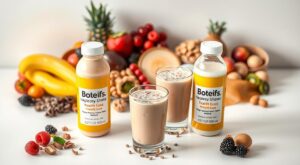Did you know changing your diet can lower your cholesterol? Many people don’t realize the impact of cholesterol lowering foods in their meals. Heart disease is a big concern in America, making it important to know which foods help lower cholesterol.
This article will show you a list of foods that can help. It will guide you toward a diet that’s good for your heart.
Understanding Cholesterol and Its Importance
Cholesterol is a waxy substance made by your liver. It’s key for making hormones and helping your body absorb vitamins. Knowing about cholesterol is vital for staying healthy.
Your body needs cholesterol for many things, but too much can harm your heart. Learning how to manage cholesterol is important to stay safe from heart disease.
About 86 million adults in the U.S. have high cholesterol. This shows how critical it is to keep an eye on your cholesterol levels. Making smart food choices can help control your cholesterol.
By understanding cholesterol’s role in your body, you can take charge of your heart health. This is key for your overall well-being.
Types of Cholesterol
Knowing about the different types of cholesterol is key for heart health. Cholesterol moves through your blood with proteins, forming lipoproteins. The main types are Low-Density Lipoprotein (LDL cholesterol) and High-Density Lipoprotein (HDL cholesterol).
LDL cholesterol is called “bad” because it can build up in your arteries. This buildup increases the risk of heart disease. It’s important to keep an eye on high levels. HDL cholesterol, on the other hand, is “good” because it helps remove cholesterol from your blood.
To keep your cholesterol levels in check, make healthy lifestyle choices. Exercise regularly, eat a balanced diet, and get regular check-ups. These steps can help you manage your cholesterol levels.
Legumes: A Healthy Fiber Option
Adding legumes to your diet is a great way to increase your fiber intake. These foods are not only tasty but also full of nutrients that help control cholesterol. Beans, peas, and lentils are all high in soluble fiber, which is key in lowering “bad” cholesterol.
Benefits of Beans, Peas, and Lentils
Beans, peas, and lentils are packed with health benefits. They are rich in soluble fiber, which helps lower cholesterol. Eating just one cup of beans a day can greatly improve your cholesterol levels. Plus, they are low in saturated fat, making them good for your heart.
How to Incorporate Legumes into Your Meals
It’s easy to add legumes to your meals. Try them in soups and salads for extra nutrition. You can make a tasty chili with beans or use lentils in grain bowls. Swapping refined grains for legumes adds fiber and variety to your meals. This change can make your food more enjoyable and help your cholesterol levels.
Avocados: The Heart-Healthy Fruit
Avocados are known as a heart-healthy fruit full of good stuff. They have monounsaturated fats and fiber, which help with cholesterol. Eating avocados can lower bad cholesterol and raise good cholesterol.
This creamy fruit is super flexible. You can put it in salads, spread it on toast, or mix it into smoothies. Adding avocados to your meals boosts flavor and helps lower cholesterol. They’re great whether you eat them sliced, mashed, or blended.

Nuts: A Crunchy Way to Lower Bad Cholesterol
Nuts are not just tasty but also great for your heart. Studies show they help lower bad cholesterol. They’re full of good fats and nutrients, making them key for heart health.
Types of Nuts Beneficial for Cholesterol
Each nut type has its own heart health benefits. Here are some of the best ones:
| Type of Nut | Healthy Fats (grams per ounce) | Fiber (grams per ounce) | Key Benefits |
|---|---|---|---|
| Walnuts | 18 | 2 | Rich in omega-3 fatty acids. |
| Almonds | 14 | 3.5 | High in Vitamin E and magnesium. |
| Pistachios | 13 | 3 | Supports healthy cholesterol levels. |
| Peanuts | 14 | 2.4 | Boosts heart health and aids in weight management. |
How to Add Nuts to Your Diet
It’s easy to add nuts to your meals. Here are some ideas to enjoy nuts’ heart health benefits:
- Add a handful of mixed nuts to your morning oatmeal for added crunch.
- Top your yogurt with walnuts or almonds for a nutritious snack.
- Blend nuts into smoothies for an extra creamy texture.
- Include them in salads for added flavor and nutrients.
- Enjoy roasted nuts as a healthy snack during the day.
Fatty Fish: Rich in Omega-3 Fatty Acids
Eating fatty fish can greatly help your heart. These fish are full of omega-3 fatty acids. They help raise good cholesterol and lower bad fats.
Heart-healthy fish like salmon, mackerel, and sardines are great. They not only help with cholesterol but also boost heart health.
The Best Types of Fatty Fish for Heart Health
Here are some top choices for fatty fish:
- Salmon
- Mackerel
- Sardines
- Trout
- Herring
These fish are packed with omega-3s. They’re perfect for anyone wanting to improve their heart health.
Cooking Methods for Healthy Fish Dishes
How you cook fish matters for its health benefits. Choose methods that preserve the fish’s omega-3s. Good options include:
- Grilling
- Steaming
- Baking
- Broiling
Using these methods, you can make tasty dishes. They’ll also boost the heart-healthy benefits of fatty fish.

Whole Grains: Oats and Barley
Whole grains are key for heart health, helping manage cholesterol. Oats and barley offer more than just fiber. They are rich in nutrients that help a low cholesterol diet. The soluble fiber in these grains, like beta-glucan, lowers “bad” cholesterol.
Why Whole Grains Matter for Cholesterol
Studies show whole grains are vital in meals. Eating them regularly can cut heart disease risk by up to 19%. This proves oats and barley are great for cholesterol control. It’s not just about taste; it’s about health benefits.
Creative Ways to Include Whole Grains
Adding whole grains to your diet can be fun and healthy. Here are some ideas:
- Start your day with a warm bowl of oatmeal topped with fruits and nuts.
- Use barley in salads or soups as a hearty ingredient.
- Experiment with whole grain breads or wraps for sandwiches.
- Try quinoa or farro, which offer similar health benefits while adding variety to your meals.
| Whole Grain | Key Benefits | Serving Suggestions |
|---|---|---|
| Oats | Reduces LDL cholesterol, high in soluble fiber | Breakfast porridge, smoothies |
| Barley | Rich in beta-glucan, promotes heart health | Salads, soups, side dishes |
Fruits and Berries: Nature’s Sweet Heart Helpers
Adding heart-healthy fruits to your meals is a tasty way to boost your cholesterol. Fruits like apples, grapes, and citrus are full of soluble fiber and antioxidants. These offer many health benefits. Berries, including strawberries and blueberries, also help manage cholesterol. Enjoying these fruits in different ways can maximize their benefits.
Key Fruits for Cholesterol Management
- Apples: Rich in pectin, a soluble fiber that can help lower LDL cholesterol.
- Citrus Fruits: Oranges and grapefruits are loaded with flavonoids that can positively affect cholesterol levels.
- Grapes: These contain resveratrol, known for its ability to improve heart health.
- Berries: Strawberries, blueberries, and raspberries offer compelling berries benefits by providing fiber and antioxidants.
How to Enjoy Fruits in Your Daily Diet
It’s easy to include fruits for lowering cholesterol in your daily meals and snacks. Try blending fruits into smoothies, adding them to salads, or snacking on them. Here are some ideas:
- Add sliced apples or berries to your morning oatmeal.
- Incorporate citrus fruits into a refreshing salad.
- Make a fruit parfait with yogurt and granola for a delicious breakfast or snack.

Dark Chocolate and Cocoa: A Delicious Treat
Dark chocolate can be a fun way to help your heart. It’s full of flavonoids, which are good for cholesterol. Studies show that dark chocolate with 75% cocoa or more can improve your cholesterol.
Dark chocolate is more than just a sweet snack. It also has antioxidants that fight oxidative stress. This helps your overall health. Choose low-sugar dark chocolate to enjoy its benefits without too much sugar.
Garlic: A Flavorful Addition with Benefits
Garlic is more than just a strong-tasting food; it’s good for your health, too. It’s great for managing cholesterol levels. Adding garlic to your food can make it taste better and help your heart.
Garlic’s active part, allicin, is known for its cholesterol-lowering effects. This makes garlic a key part of any diet aimed at lowering cholesterol.
How Garlic Affects Cholesterol Levels
Studies show garlic can help keep cholesterol levels healthy. Eating garlic, whether whole, crushed, or in supplements, can lower LDL cholesterol. This is good for your heart.
By adding garlic to your meals, you can make them healthier. Garlic not only adds flavor but also helps manage cholesterol naturally.

Soy Foods: Plant-Based Protein Alternatives
Soy products are great for heart health. They include tofu, tempeh, and soy milk. These foods are full of nutrients that help control cholesterol.
Studies show that eating soy can lower LDL cholesterol. This is good for your heart.
Different Ways to Consume Soy
Soy is easy to add to your meals and tastes good. Here are some ideas:
- Tofu Stir-Fry: Add tofu to vegetable stir-fries for a protein boost.
- Tempeh Tacos: Use tempeh as a filling for tacos, complemented by fresh toppings.
- Smoothies with Soy Milk: Blend soy milk with your favorite fruits for a nutritious drink.
- Salads with Edamame: Toss edamame into salads for added texture and protein.
- Soups with Miso: Use miso paste in soups to enhance flavor and nutrition.
Adding different soy products to your diet is healthy and tasty. You’ll enjoy new flavors and get the benefits of plant-based proteins.
Vegetables: The Colorful Foundation of a Heart-Healthy Diet
Eating a variety of vegetables is great for your heart. They are full of fiber and nutrients. These foods help control cholesterol levels. Many vegetables are good for your heart, helping lower bad cholesterol and improving heart health.
Vegetables That Specificallly Help Lower Cholesterol
Some vegetables are better than others at lowering cholesterol. Here are the top picks:
| Vegetable | Benefits |
|---|---|
| Kale | High in fiber, essential for managing LDL cholesterol |
| Spinach | Rich in antioxidants and nutrients that promote heart health |
| Brussels Sprouts | Loaded with soluble fiber, they help reduce LDL cholesterol |
| Broccoli | Contains sulforaphane, which may help lower blood cholesterol levels |
| Carrots | Provide soluble fibers and can aid in reducing cholesterol levels |
Incorporating More Vegetables into Your Diet
Eating a variety of colorful vegetables is key for heart health. Here’s how to add more to your meals:
- Try steaming or roasting different vegetables to keep nutrients and add flavor.
- Add them to soups, stews, or smoothies for a nutritional boost.
- Use raw vegetables as a crunchy topping on salads or sandwiches.
Vegetables do more than just help with cholesterol. They support your heart and overall health. For more tips on managing cholesterol through diet, check out this informative link.
Tea: Sip Away Cholesterol
Adding tea to your daily routine can be a fun way to boost your heart health. Green tea, in particular, is packed with antioxidants like catechins. These help keep your tea and cholesterol levels in check by reducing LDL cholesterol.
Drinking several cups of tea a day is a great way to stay hydrated and enjoy different flavors. Whether you like black, green, or white tea, trying new types can make your day better. It also helps your heart stay healthy.
Tea can be enjoyed hot or cold, making it easy to add to your daily routine. Drinking green tea regularly can improve your health and help manage cholesterol levels.
Dark Leafy Greens: Nutrient Powerhouses
Adding dark leafy greens to your diet can change the game for cholesterol management. Kale, Swiss chard, and spinach are not just colorful additions. They are nutrient-rich vegetables full of vitamins and minerals. Their high fiber content helps remove excess cholesterol, making them key for heart health.
The health benefits of greens go beyond just cholesterol control. These greens offer antioxidants that boost overall health, aid digestion, and improve skin. Adding different greens to your meals can enrich your nutrient intake and make food more exciting.
Here are some popular dark leafy greens you can add to your diet:
- Kale
- Collard Greens
- Swiss Chard
- Spinach
- Mustard Greens
It’s easy to add these dark leafy greens for cholesterol to your meals. You can use them in salads, smoothies, or as side dishes. Their versatility makes them a great choice for anyone wanting to boost heart health and enjoy new flavors and textures.
| Dark Leafy Green | Calories (per 1 cup) | Fiber (grams) | Key Nutrients |
|---|---|---|---|
| Kale | 33 | 2.5 | Vitamins A, C, K |
| Swiss Chard | 35 | 3.7 | Magnesium, Potassium, Iron |
| Spinach | 7 | 0.7 | Folate, Vitamin K |
By adding these nutrient-rich vegetables to your meals, you can make tasty, cholesterol-friendly dishes. Don’t overlook the power of greens in achieving better heart health.
Extra Virgin Olive Oil: A Mediterranean Classic
Extra virgin olive oil is more than just a tasty ingredient. It’s also great for your heart. It’s full of monounsaturated fats that help with cholesterol. This makes it a key part of the Mediterranean diet.
Health Benefits of Olive Oil for Cholesterol
Adding olive oil to your meals can really help your cholesterol. Eating about 20 grams a day can boost your HDL, or “good,” cholesterol. It also has antioxidants that are good for your heart.
Here are some ways to use olive oil for health:
- Drizzle it over salads for flavor.
- Use it to sauté veggies for taste and health.
- Make dips and spreads with olive oil for extra richness.
Keep olive oil in your kitchen. It makes food taste better and helps keep your cholesterol healthy.
Conclusion
Adding these 20 foods to your diet can really help lower your cholesterol. This supports a heart-healthy lifestyle. You can choose from many options like legumes, avocados, and fruits and vegetables.
Remember, eating well and staying active are key. These changes can make a big difference in your heart health. Start now and see how it improves your health in the future.
Exploring heart-healthy foods is easy and fun. Try these tasty options and see how they help you reach your health goals.













